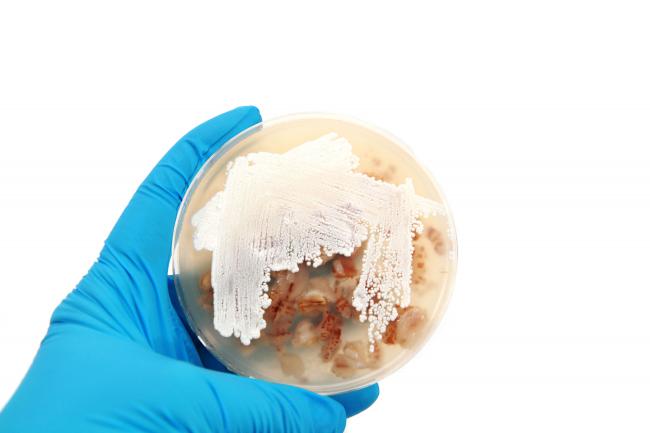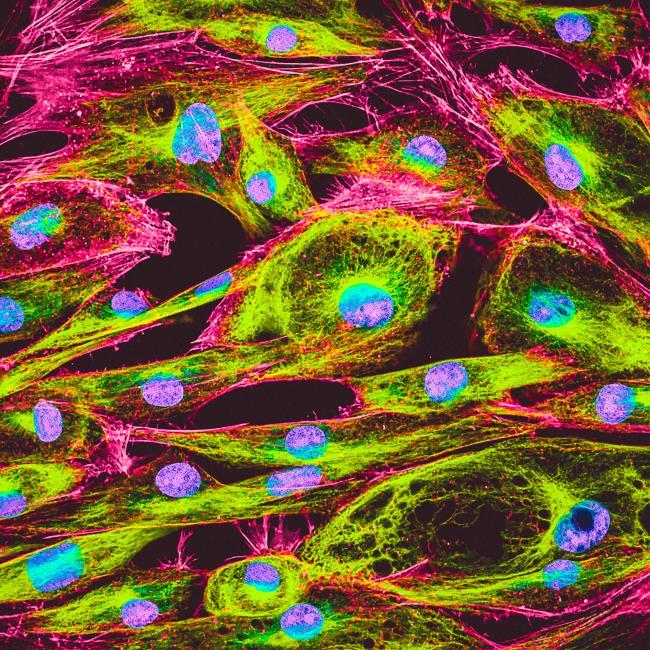Puromycin is a potent antibiotic. It is a widely used research tool in molecular biology and biomedical research. Puromycin is produced from the bacterium Streptomyces alboniger, a gram-positive actinomycete, through a series of enzymatic reactions starting from adenosine triphosphate (ATP)1. This compound has unique properties that make it invaluable for studying protein synthesis and as a selective agent in cell culture.
Puromycin is a naturally occurring aminonucleoside antibiotic that inhibits protein synthesis by ribosome-catalyzed incorporation into the C-terminus of elongating nascent chains, blocking further extension and resulting in premature termination of translation1. It is also most commonly known as a selection marker for cell lines genetically engineered to express a resistance gene1. This antibiotic inhibits the growth of gram-positive bacteria in many animal and insect cells. Puromycin is weakly active against gram-negative microorganisms. It has antimicrobial, antitrypanosomal, and anti-infective, antitumor, antineoplastic properties1,2. Puromycin has a fast mode of action, causing rapid cell death at low antibiotic concentrations. The recommended dose as a selection agent in mammalian cell cultures is within a range of 1-10 μg/ml. According to the Register of Toxic Effects of Chemical Substances (RTECS), LD50 value in rats is 20 mg/kg (oral), 25 mg/kg (intraperitoneal), and 15 mg/kg (intravenous). It has been shown that injections of this antibiotic result in both short-term and single-term memory loss in mice.
Puromycinis composed of a nucleoside covalently bound to an amino acid, mimicks the 3' end of aminoacylated tRNAs that participate in delivery of amino acids to elongating ribosomes1.
Applications in Molecular Biology:
- Protein Synthesis Studies: One of the most significant applications of Puromycin is in the study of protein synthesis. By inducing premature termination of protein translation, researchers can analyze the mechanisms of ribosomal function, mRNA translation, and the role of various translation factors. This has led to a deeper understanding of how proteins are synthesized and regulated within the cell.
- Selective Agent in Cell Culture: Puromycin is widely used as a selective agent in molecular biology to select cells that have been transfected with a plasmid containing a Puromycin resistance gene. This application is crucial in gene expression studies, functional genomics, and the production of stable cell lines. Only cells that have successfully integrated the resistance gene can survive in the presence of Puromycin, allowing for the selection of genetically modified cells.
- Polysome Profiling: Researchers use Puromycin in polysome profiling to study the distribution of ribosomes on mRNAs. By adding Puromycin to cell lysates, researchers can freeze ribosomes in place, allowing them to analyze which mRNAs are being actively translated. This technique provides insights into translational control and the regulation of gene expression at the level of mRNA translation.
- mRNA Translation Inhibition Studies: Puromycin is also used to study inhibitors of mRNA translation. By comparing the effects of various compounds on protein synthesis in the presence of Puromycin, researchers can identify potential therapeutic agents that target translational machinery particularly relevant in cancer research where protein synthesis is often dysregulated.
Advantages of Puromycin:
- High Specificity: Puromycin specifically targets the ribosome, providing a precise tool for studying protein synthesis.
- Efficiency: Its ability to rapidly induce cell death makes it an effective selective agent in cell culture.
- Versatility: Puromycin can be used across various research applications, from basic molecular biology to applied biomedical research.
Limitations of Puromycin:
- Toxicity: The same property that makes Puromycin an effective selective agent also limits its use in living organisms due to its high toxicity.
- Resistance Development: Over time, cells can develop resistance to Puromycin, which may complicate long-term experiments.
- Non-specific Effects: At higher concentrations, Puromycin may have off-target effects, necessitating careful titration and control experiments.
In addition to its role in basic research, Puromycin has significant implications in biomedical research. Its ability to inhibit protein synthesis is particularly useful in cancer studies. Cancer cells often have dysregulated protein synthesis pathways, and Puromycin can be used to target these cells selectively. Moreover, by studying the mechanisms of Puromycin resistance, researchers can gain insights into drug resistance mechanisms in cancer and other diseases.
Puromycin has also been used in the development of new therapeutic strategies. Since the discovery of its chemical structure, Puromycin has been modified using both nucleotide and amino acid chemistries, generating a wide range of radiolabeled, fluorescent, biotinylated and photoactivatable derivatives1,3. This targeted approach could potentially reduce the compound's toxicity while maintaining its efficacy, opening new avenues for its use in clinical settings.
In conclusion, since its discovery more than half a century ago, Puromycin has helped shape our understanding of ribosome function and protein synthesis kinetics. It laid the groundwork for establishing a link between translation regulation and fundamental biological processes across a diverse range of normal development and disease models, including cancer, viral infection and neurodegeneration1.
Fermentek offers pure Puromycin dihydrochloride, Puromycin amino nucleoside and Puromycin dihydrochloride animal free, which can be used for cell biology research, enzymatic embolic studies, hormonal system studies as well as a selection in vitro antibiotics.
- Aviner R. The science of Puromycin: From studies of ribosome function to applications in biotechnology. Comput Struct Biotechnol J. 2020 Apr 24;18:1074-1083. doi: 10.1016/j.csbj.2020.04.014. PMID: 32435426; PMCID: PMC7229235.
- Hitzerd, S.M., Verbrugge, S.E., Ossenkoppele, G. et al. Positioning of aminopeptidase inhibitors in next generation cancer therapy. Amino Acids 46, 793–808 (2014).
- Hadidi K, Steinbuch KB, Dozier LE, Patrick GN, Tor Y. Inherently Emissive Puromycin Analogues for Live Cell Labelling. Angew Chem Int Ed Engl. 2023 Jun 5;62(23):e202216784. doi: 10.1002/anie.202216784. Epub 2023 Apr 27. PMID: 36973168; PMCID: PMC10213139.







